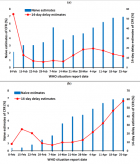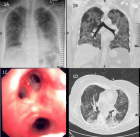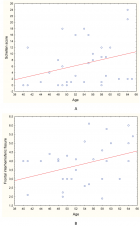Abstract
Review Article
A Review on Heavy Metals in Ecosystems, Their Sources, Roles, and Impact on Plant Life
Humaira Aslam, Ali Umar, Misbah Ullah Khan*, Shehla Honey, Aman Ullah, Muhammad Ahsan Ashraf, Ghulam Ayesha, Nazia Nusrat, M Jamil, Shahid Khan and Adeel Abid
Published: 21 August, 2024 | Volume 7 - Issue 1 | Pages: 020-034
The presence of heavy metals (HMs) on Earth is essential to all forms of life. These metals are essential for plant and animal development but can have numerous negative effects on the living environment. In this review, we looked at where HMs come from, why they are harmful, and how they affect plants. Articles indexed in Google Scholar, PubMed, Research Gate, Science Direct, and a few books on heavy metals were consulted for this study. Heavy metals are essential for plant development and growth. According to this analysis, the hazardous effects of HMs are on the rise all throughout the globe, and this trend may be attributed mostly to human activity. Because of its impact on agricultural productivity and environmental changes, soil pollution caused by HMs is among the most crucial elements. Plants have evolved very sophisticated defense systems to deal with these environmental challenges. The threat that HM stress poses to plants has attracted a lot of attention worldwide because it could stunt agriculture’s long-term expansion. In spite of their importance for plants, this study found that HMs pose a significant threat to plant life. The novelty of this review lies in its detailed examination of both the beneficial and detrimental roles of HMs, providing a balanced perspective often overlooked in current literature. The significance of this work is underscored by its potential to inform sustainable agricultural practices and environmental management strategies, as it highlights the delicate balance required to harness the benefits of HMs while mitigating their risks. Despite their necessity for plant development, this review underscores the significant risks HMs pose to plant health and ecosystems.Less than 10 cases have been reported in the literature of the association of germline BRCA1 and Squamous cell Carcinoma – the esophagus. The article focuses on the probable pathogenesis of BRCA1 mutation with non-classic malignancies and the response of Poly adenosine diphosphate ribose polymerase inhibitors (PARP) inhibitors in such a scenario. We report an unusual manifestation of the BRCA1 gene with second primary oesophageal squamous cell cancer occurring five years later to triple-negative breast cancer.
Read Full Article HTML DOI: 10.29328/journal.jgmgt.1001012 Cite this Article Read Full Article PDF
Keywords:
Heavy metals (HMs); Plants; Growth and development; HMs toxicity
References
- Tchounwou PB, Yedjou CG, Patlolla AK, Sutton DJ. Heavy metal toxicity and the environment. In: Molecular, Clinical and Environmental Toxicology: Volume 3: Environmental Toxicology. 2012:133-64. Available from: https://doi.org/10.1007/978-3-7643-8340-4_6
- Lang PF. Bonding, structure and uses of metals. J Metal Mater Res. 2023;6(1). Available from: https://doi.org/10.30564/jmmr.v6i1.5173
- Wang B, Lan J, Bo C, Gong B, Ou J. Adsorption of heavy metal onto biomass-derived activated carbon. RSC Adv. 2023;13(7):4275-302. Available from: https://doi.org/10.1039%2Fd2ra07911a
- Kumari S, Mishra A. Heavy metal contamination. In: Soil Contamination-Threats and Sustainable Solutions. IntechOpen; 2021. Available from: https://www.intechopen.com/chapters/72968
- Madhu PM, Sadagopan RS. Effect of heavy metals on growth and development of cultivated plants with reference to cadmium, chromium and lead–a review. J Stress Physiol Biochem. 2020;16(3):84-102. Available from: https://web.archive.org/web/20201124230326id_/http://www.jspb.ru/issues/2020/N3/JSPB_2020_3_84-102.pdf
- Balali-Mood M, Naseri K, Tahergorabi Z, Khazdair MR, Sadeghi M. Toxic mechanisms of five heavy metals: mercury, lead, chromium, cadmium, and arsenic. Front Pharmacol. 2021;12:227. Available from: https://doi.org/10.3389%2Ffphar.2021.643972
- Vetrimurugan E, Brindha K, Elango L, Ndwandwe OM. Human exposure risk to heavy metals through groundwater used for drinking in an intensively irrigated river delta. Appl Water Sci. 2017;7:3267-3280. Available from: https://ui.adsabs.harvard.edu/link_gateway/2017ApWS....7.3267V/doi:10.1007/s13201-016-0472-6
- Qin G, Niu Z, Yu J, Li Z, Ma J, Xiang P. Soil heavy metal pollution and food safety in China: Effects, sources and removing technology. Chemosphere. 2021;267:129205. Available from: https://doi.org/10.1016/j.chemosphere.2020.129205
- Miller R. The elements: what you really want to know. Twenty-First Century Books; 2006. Available from: https://librarycatalog.cityofwoodland.gov/Record/.b17940795
- Boldyrev M. Lead: properties, history, and applications. WikiJ Sci. 2018;1(2):1-23. Available from: https://doi.org/10.15347/wjs%2F2018.007
- Ara A, Usmani JA. Lead toxicity: a review. Interdiscip Toxicol. 2015;8(2):55-64. Available from: https://doi.org/10.1515%2Fintox-2015-0009
- Levin R, Vieira CLZ, Rosenbaum MH, Bischoff K, Mordarski DC, Brown MJ. The urban lead (Pb) burden in humans, animals and the natural environment. Environ Res. 2021;193:110377. Available from: https://doi.org/10.1016/j.envres.2020.110377
- Jones FN, Nichols ME, Pappas SP. Organic coatings: science and technology. John Wiley & Sons. 2017. Available from: https://onlinelibrary.wiley.com/doi/book/10.1002/9781119337201
- Dignam T, Kaufmann RB, LeStourgeon L, Brown MJ. Control of lead sources in the United States, 1970-2017: public health progress and current challenges to eliminating lead exposure. J Public Health Manag Pract. 2019;25(Suppl 1 LEAD POISONING PREVENTION). Available from: https://doi.org/10.1097%2FPHH.0000000000000889
- Clausen J, Bostick B, Korte N. Migration of lead in surface water, pore water, and groundwater with a focus on firing ranges. Crit Rev Environ Sci Technol. 2011;41(15):1397-1448. Available from: http://dx.doi.org/10.1080/10643381003608292
- Siegmund A. Primary lead production–a survey of existing smelters. In: Lead-Zinc. 2000:53-116. Available from: https://gcteng.com/wp-content/uploads/2000_Primary_Lead_Survey.pdf
- WATER D, ENTERS HL. Lead in drinking water. 2012.
- Dunn DJ. Water Delivery Report 2008. 2008. Available from: https://curaflo.com/wp-content/uploads/2017/07/CuraFloWaterDeliveryrReport2008-3_0.pdf
- Maas RP, Patch SC, Morgan DM, Pandolfo TJ. Reducing lead exposure from drinking water: recent history and current status. Public Health Rep. 2005;120(3):316-321. Available from: https://doi.org/10.1177%2F003335490512000317
- Venkatesh DT, Paul A. Lead testing in soil contaminated with lead and reducing its effects on humans by the activity of activated lead. Available from: https://www.researchgate.net/publication/303387938_LEAD_TESTING_IN_SOIL_CONTAMINATED_WITH_LEAD_AND_REDUCING_ITS_EFFECTS_OF_HUMAN_BY_THE_ACTIVITY_OF_ACTIVATED_LEAD
- Suliman NOF. Factors affecting child health with focus on lead element pollution: a case study of Greater Wad Medani Locality Gezira State-Sudan (2017). University of Gezira; 2018. Available from:
- Singh R, Parthvi R, Parthvi P, Agarwal J, Gupta P. Heavy metal contamination of spices. 2013; 3(1):47-65. Available from: https://www.researchgate.net/publication/320211984_HEAVY_METAL_CONTAMINATION_OF_SPICES
- Slade G. Made to break: Technology and obsolescence in America. Harvard University Press; 2006. Available from: https://books.google.co.in/books/about/Made_to_Break.html?id=YMoxdac6J-cC&redir_esc=y
- Hunt WG, Crum B, Watson RT, et al. Lead bullet fragments in venison from rifle-killed deer: potential for human dietary exposure. PLoS One. 2009;4(4).
- Zhang H, F Wang, Y Lu, Q Sun, Y Xu, BB Zhang, et al. High-sensitivity X-ray detectors based on solution-grown caesium lead bromide single crystals. J Mater Chem C. 2020;8(4):1248-1256. Available from: https://pubs.rsc.org/en/content/articlelanding/2020/tc/c9tc05490a
- Juberg DR, Kleiman CF, Kwon SC. Position paper of the American Council on Science and Health: lead and human health. Ecotoxicol Environ Saf. 1997;38(3):162-180. Available from: https://doi.org/10.1006/eesa.1997.1591
- Hossain MA, Piyatida P, da Silva JAT, Fujita M. Molecular mechanism of heavy metal toxicity and tolerance in plants: central role of glutathione in detoxification of reactive oxygen species and methylglyoxal and in heavy metal chelation. J Botany. 2012;2012:1-19. Available from: https://doi.org/10.1155/2012/872875
- Fahr M, Popp M, Schubert S. Effect of lead on root growth. Front Plant Sci. 2013;4:175. Available from: https://doi.org/10.3389/fpls.2013.00175
- Emamverdian A, Ding Y, Mokhberdoran F, Xie Y. Heavy metal stress and some mechanisms of plant defense response. Sci World J. 2015;2015:1-9. Available from: https://doi.org/10.1155%2F2015%2F756120
- Tuteja N, Gill SS, Tuteja R. Plant responses to abiotic stresses: shedding light on salt, drought, cold and heavy metal stress. In: Omics and Plant Abiotic Stress Tolerance. 2011;1:39-64. Available from: http://dx.doi.org/10.2174/97816080505811110101
- Aslam R, Bhat TM, Choudhary S, Ansari M. An overview on genotoxicity of heavy metal in a spice crop (Capsicum annuum L.) in respect to cyto-morphological behaviour. Caryologia. 2017;70(1):42-47. Available from: https://doi.org/10.1080/00087114.2016.1258884
- McAllister TA, Ribeiro G, Stanford K, Wang Y. Forage-induced animal disorders. In: Forages: The Science of Grassland Agriculture. 2020;2:839-860. Available from: https://www.scirp.org/reference/referencespapers?referenceid=3318471
- Pandey G, Madhuri S. Heavy metals causing toxicity in animals and fishes. Res J Anim Vet Fish Sci. 2014;2(2):17-23. Available from: https://www.researchgate.net/publication/303213699_Heavy_metals_causing_toxicity_in_animals_and_fishes
- Knez E, Kadac-Czapska K, Dmochowska-Ślęzak K, Grembecka M. Root vegetables—composition, health effects, and contaminants. Int J Environ Res Public Health. 2022;19(23):15531. Available from: https://doi.org/10.3390/ijerph192315531
- Gracia RC, Snodgrass WR. Lead toxicity and chelation therapy. Am J Health Syst Pharm. 2007;64(1):45-53. Available from: https://doi.org/10.2146/ajhp060175
- Mosheiff R, Weil Y, Khoury A, Liebergall M. The use of computerized navigation in the treatment of gunshot and shrapnel injury. Comput Aided Surg. 2004;9(1-2):39-43. Available from: https://doi.org/10.3109/10929080400006382
- Neubauer U, Furrer G, Kayser A, Schulin R. Siderophores, NTA, and citrate: potential soil amendments to enhance heavy metal mobility in phytoremediation. Int J Phytoremediation. 2000;2(4):353-68. Available from: http://dx.doi.org/10.1080/15226510008500044
- Hauptman M, Bruccoleri R, Woolf AD. An update on childhood lead poisoning. Clin Pediatr Emerg Med. 2017;18(3):181-192. Available from: https://doi.org/10.1016%2Fj.cpem.2017.07.010
- Committee on Environmental Hazards, Committee on Accident Prevention, Committee on Environmental Health. Statement on childhood lead poisoning. Pediatrics. 1987;79(3):457-465. Available from: https://pubmed.ncbi.nlm.nih.gov/3822655/
- Lowry JA. Oral chelation therapy for patients with lead poisoning. Am Acad Pediatr. 2010;116:1036-1046. Available from: https://jeffreydachmd.com/wp-content/uploads/2015/07/Lead_Oral_Chelators_J_A_Lowry_2010.pdf
- Lin C-J, Pehkonen SO. The chemistry of atmospheric mercury: a review. Atmos Environ. 1999;33(13):2067-2079. Available from: http://dx.doi.org/10.1016/S1352-2310(98)00387-2
- Sidhaarth DK, Baskar S. A review on adsorption of nickel and mercury from aqueous solution using nanoparticles. Int J Civil Eng Technol. 2018;9(9): 1246-1255. Available from: https://www.researchgate.net/publication/362668219_A_Review_on_Adsorption_of_Nickel_and_Mercury_from_Aqueous_Solution_using_Nanoparticles
- Trüeb RM, Trüeb RM. The hair cycle and its relation to nutrition. In: Nutrition for Healthy Hair: Guide to Understanding and Proper Practice. 2020:37-109. Available from: https://www.amazon.in/Nutrition-Healthy-Hair-Understanding-Practice/dp/3030599191
- Blue LY. Immobilization of mercury and arsenic through covalent thiolate bonding for the purpose of environmental remediation. University of Kentucky; 2010. Available from: https://uknowledge.uky.edu/cgi/viewcontent.cgi?params=/context/gradschool_diss/article/1788/&path_info=Blue_Diss_FINAL.pdf
- Khanna VK. Fundamentals of solid-state lighting: LEDs, OLEDs, and their applications in illumination and displays. CRC Press; 2014. Available from: https://doi.org/10.1201/b17076
- He F, Gao J, Pierce E, Strong P, Wang H, Liang L. In situ remediation technologies for mercury-contaminated soil. Environ Sci Pollut Res. 2015;22:8124-8147. Available from: https://doi.org/10.1007/s11356-015-4316-y
- Gomes CS, Silva EA. Health benefits and risks of minerals: bioavailability, bio-essentiality, toxicity, and pathologies. In: Minerals latu sensu and Human Health: Benefits, Toxicity and Pathologies. Springer; 2021; 81-179. Available from: http://dx.doi.org/10.1007/978-3-030-65706-2_4
- Kim M-K, Zoh K-D. Fate and transport of mercury in environmental media and human exposure. J Prev Med Public Health. 2012;45(6):335. Available from: https://doi.org/10.3961%2Fjpmph.2012.45.6.335
- Desforges JPW, Yurkowski DJ, Nilsen EA, et al. Mercury and neurochemical biomarkers in multiple brain regions of five Arctic marine mammals. Neurotoxicol. 2021;84:136-145. Available from: https://doi.org/10.1016/j.neuro.2021.03.006
- MacDonald T. Effects of inorganic mercury on developing zebrafish (Danio rerio) larvae. University of Saskatchewan; 2015. Available from: https://core.ac.uk/download/pdf/226135712.pdf
- Chauke T. Geology and geochemistry of Muyexe magnesite deposit, Giyani Greenstone Belt, Limpopo Province, South Africa. 2020. Available from: https://univendspace.univen.ac.za/handle/11602/1624
- Khan MA, Siddiqi ZA. Mercury: sources, toxicity and remediation. In: Heavy Metals.1.
- Antonelli MC, Pallarés ME, Ceccatelli S, Spulber S. Long-term consequences of prenatal stress and neurotoxicants exposure on neurodevelopment. Prog Neurobiol. 2017;155:21-35. Available from: https://doi.org/10.1016/j.pneurobio.2016.05.005
- Gil A, Gil F. Fish, a Mediterranean source of n-3 PUFA: benefits do not justify limiting consumption. Br J Nutr. 2015;113(S2). Available from: https://doi.org/10.1017/s0007114514003742
- Atti SK, Cushing T, Oladele A, Casteel S, Kiernan E, Dela Cruz R, et al. All that glitters is not gold: mercury poisoning in a family mimicking an infectious illness. Curr Probl Pediatr Adolesc Health Care. 2020;50(2):100758. Available from: https://doi.org/10.1016/j.cppeds.2020.100758
- Stambulska UY, Bayliak MM, Lushchak VI. Chromium (VI) toxicity in legume plants: modulation effects of rhizobial symbiosis. Biomed Res Int. 2018;2018:1-8. Available from: https://doi.org/10.1155/2018/8031213
- Liu X. Chlorin-like photosensitizers for photodynamic therapy. University of British Columbia; 2005. Available from: https://open.library.ubc.ca/soa/cIRcle/collections/ubctheses/831/items/1.0061112
- Dary M, Chamber-Pérez MA, Palomares A, Pajuelo E. “In situ” phytostabilisation of heavy metal polluted soils using Lupinus luteus inoculated with metal resistant plant-growth promoting rhizobacteria. J Hazard Mater. 2010;177(1-3):323-330. Available from: https://doi.org/10.1016/j.jhazmat.2009.12.035
- Mani D, Kumar C. Biotechnological advances in bioremediation of heavy metals contaminated ecosystems: an overview with special reference to phytoremediation. Int J Environ Sci Technol. 2014;11:843-872. Available from: http://dx.doi.org/10.1007/s13762-013-0299-8
- Jean-Philippe SR, Franklin JA, Buckley DS, Hughes K. The effect of mercury on trees and their mycorrhizal fungi. Environ Pollut. 2011;159(10):2733-2739. Available from: https://doi.org/10.1016/j.envpol.2011.05.017
- Chan H, Scheuhammer A, Ferran A, Loupelle C, Holloway J, Weech S. Impacts of mercury on freshwater fish-eating wildlife and humans. Hum Ecol Risk Assess. 2003;9(4):867-883. Available from: http://dx.doi.org/10.1080/713610013
- Desrosiers M, Planas D, Mucci A. Mercury methylation in the epilithon of boreal shield aquatic ecosystems. Environ Sci Technol. 2006;40(5):1540-1546. Available from: http://dx.doi.org/10.1021/es0508828
- Sharma S, Nagpal A, Vig AP. Genoprotective potential of Brassica juncea (L.) Czern. against mercury-induced genotoxicity in Allium cepa L. Turk J Biol. 2012;36(6):622-629. Available from: https://journals.tubitak.gov.tr/cgi/viewcontent.cgi?article=1740&context=biology
- Agarwal M, Rathore RS, Jagoe CH, Chauhan A. Multiple lines of evidences reveal mechanisms underpinning mercury resistance and volatilization by Stenotrophomonas sp. MA5 isolated from the Savannah River Site (SRS), USA. Cells. 2019;8(4):309. Available from: https://doi.org/10.3390/cells8040309
- Silver S, Phung LT. Bacterial heavy metal resistance: new surprises. Annu Rev Microbiol. 1996;50:753-789. Available from: https://doi.org/10.1146/annurev.micro.50.1.753
- Barkay T, Miller SM, Summers AO. Bacterial mercury resistance from atoms to ecosystems. FEMS Microbiol Rev. 2003;27(2-3):355-384. Available from: https://doi.org/10.1016/s0168-6445(03)00046-9
- Gatehouse LN. Construction of a cDNA library encoding pea seed proteins. Durham University; 1985. Available from: https://etheses.dur.ac.uk/7118/
- Gupta DK, Vandenhove H, Inouhe M. Role of phytochelatins in heavy metal stress and detoxification mechanisms in plants. In: Heavy metal stress in plants. 2013; 73-94. Available from: http://dx.doi.org/10.1007/978-3-642-38469-1_4
- Yadav SK. Heavy metals toxicity in plants: an overview on the role of glutathione and phytochelatins in heavy metal stress tolerance of plants. S Afr J Bot. 2010;76(2):167-179. Available from: https://doi.org/10.1016/j.sajb.2009.10.007
- I I I H Works. A guide to mercury reduction in industrial and commercial settings. 2001. Available from: https://archive.epa.gov/region5/mercury/web/pdf/delta%20inst%20merc%20red%20guide%20ind%20comm%2001.pdf
- Lee K. 2022 Solid-state lighting R&D opportunities. Guidehouse; 2022. Available from: https://www.energy.gov/sites/default/files/2022-02/2022-ssl-rd-opportunities.pdf
- Cheng H, Hu Y. Mercury in municipal solid waste in China and its control: a review. Environ Sci Technol. 2012;46(2):593-605. Available from: https://doi.org/10.1021/es2026517
- Cabaniss AD. Handbook on household hazardous waste. Rowman & Littlefield; 2018. Available from: https://books.google.co.in/books?hl=en&lr=&id=745iDwAAQBAJ&oi=fnd&pg=PP2&dq=73.%09Cabaniss+AD.+Handbook+on+household+hazardous+waste.+Rowman+%26+Littlefield%3B+2018&ots=WJZsBTglJL&sig=NtH2bD50zQFmwDeKrr5xwxplQmk&redir_esc=y#v=onepage&q=73.%09Cabaniss%20AD.%20Handbook%20on%20household%20hazardous%20waste.%20Rowman%20%26%20Littlefield%3B%202018&f=false
- Shuaib M, Azam N, Bahadur S, Romman M, Yu Q, Xuexiu C. Variation and succession of microbial communities under the conditions of persistent heavy metal and their survival mechanism. Microb Pathog. 2021;150:104713. Available from: https://doi.org/10.1016/j.micpath.2020.104713
- Fatoki OS, Akinsoji OS, Ximba BJ, Olujimi O, Ayanda OS. Arsenic contamination: Africa the missing gap. 2013; 25: 16. Available from: https://doi.org/10.14233/ajchem.2013.15360
- Mou SA, Kabir MH, Yasmin S, Ahmed S. Arsenic mitigation technologies from ground water: a brief review.2022; 2(5):139-158. Available from: http://dx.doi.org/10.34104/ajpab.020.01390158
- Letsoalo MR. Speciation of arsenic water and sediments from Mokolo and Great Letaba Rivers, Limpopo Province. 2017. Available from: http://hdl.handle.net/10386/1927
- Du Laing G, Rinklebe J, Vandecasteele B, Meers E, Tack FM. Trace metal behaviour in estuarine and riverine floodplain soils and sediments: a review. Sci Total Environ. 2009;407(13):3972-3985. Available from: https://doi.org/10.1016/j.scitotenv.2008.07.025
- Kulsum PG, Khanam R, Das S, Nayak AK, Tack FMG, Meers E, et al. A state-of-the-art review on cadmium uptake, toxicity, and tolerance in rice: from physiological response to remediation process. Environ Res. 2022;115098. Available from: https://doi.org/10.1016/j.envres.2022.115098
- Ishimaru Y, Takahashi R, Bashir K, Shimo H, Senoura T, Sugimoto K, et al. Characterizing the role of rice NRAMP5 in manganese, iron and cadmium transport. Sci Rep. 2012;2(1):286. Available from: https://doi.org/10.1038%2Fsrep00286
- Frossard E, Bucher M, Mächler F, Mozafar A, Hurrell RF. Potential for increasing the content and bioavailability of Fe, Zn and Ca in plants for human nutrition. J Sci Food Agric. 2000;80(7):861-79. Available from: http://dx.doi.org/10.1002/(SICI)1097-0010(20000515)80:7%3C861::AID-JSFA601%3E3.3.CO;2-G
- Yang Y, Xie J, Li J, Zhang J, Zhang X, Yao Y, Wang C, et al. Trehalose alleviates salt tolerance by improving photosynthetic performance and maintaining mineral ion homeostasis in tomato plants. Front Plant Sci. 2022;13:974507. Available from: https://doi.org/10.3389/fpls.2022.974507
- Tangahu BV, Sheikh Abdullah SR, Basri H, Idris M, Anuar N, Mukhlisin M. A review on heavy metals (As, Pb, and Hg) uptake by plants through phytoremediation. Int J Chem Eng. 2011;2011:939161. Available from: http://dx.doi.org/10.1155/2011/939161
- Alamo-Nole L, Su YF. Translocation of cadmium in Ocimum basilicum at low concentration of CdSSe nanoparticles. Appl Mater Today. 2017;9:314-318. Available from: https://doi.org/10.1007%2Fs40201-022-00822-1
- Bolan NS, Park JH, Robinson B, Naidu R, Huh KY. Phytostabilization: a green approach to contaminant containment. Adv Agron. 2011;112:145-204. Available from: https://research-repository.uwa.edu.au/en/publications/phytostabilization-a-green-approach-to-contaminant-containment
- Thirkell TJ. The influence of nitrogen source on the nutrition of arbuscular mycorrhizal plants. University of York; 2016. Available from: https://etheses.whiterose.ac.uk/17272/1/Thomas%20James%20Thirkell%20Thesis%20-%20corrected.pdf
- Nwoko CO. Trends in phytoremediation of toxic elemental and organic pollutants. Afr J Biotechnol. 2010;9(37):6010-6016. Available from: https://academicjournals.org/journal/AJB/article-full-text-pdf/894CB7C20320
- Asati A, Pichhode M, Nikhil K. Effect of heavy metals on plants: an overview. Int J Appl Innov Eng Manag. 2016;5(3):56-66. Available from: https://www.researchgate.net/profile/Mohnish-Pichhode/publication/336148391_Effect_of_Heavy_Metals_on_Plants_An_Overview/links/5d92ef25299bf10cff1cd4af/Effect-of-Heavy-Metals-on-Plants-An-Overview.pdf
- Wang W. Literature review on higher plants for toxicity testing. Water Air Soil Pollut. 1991;59:381-400. Available from: https://link.springer.com/article/10.1007/BF00211845
- Jaishankar M, Tseten T, Anbalagan N, Mathew BB, Beeregowda KN. Toxicity, mechanism and health effects of some heavy metals. Interdiscip Toxicol. 2014;7(2):60-72. Available from: https://doi.org/10.2478%2Fintox-2014-0009
- Ivanov V, Zhukovskaya N. Effect of heavy metals on root growth and the use of roots as test objects. Russ J Plant Physiol. 2021;68. Available from: http://dx.doi.org/10.1134/S1021443721070049
- Sharma P, Jha AB, Dubey RS, Pessarakli M. Reactive oxygen species, oxidative damage, and antioxidative defense mechanism in plants under stressful conditions. J Bot. 2012;2012:1-26. Available from: https://doi.org/10.1155/2012/217037
- Sárvári É. Effect of Cd on the iron re-supply-induced formation of chlorophyll-protein complexes in cucumber. Acta Biol Szeged. 2008;52(1):183-186. Available from: https://abs.bibl.u-szeged.hu/index.php/abs/article/view/2618
- Pandhair V, Sekhon BS. Reactive oxygen species and antioxidants in plants: an overview. J Plant Biochem Biotechnol. 2006;15:71-78. Available from: http://dx.doi.org/10.1007/BF03321907
- Huang Z-C, Chen T-B, Lei M, Liu Y-R, Hu T-D. Difference of toxicity and accumulation of methylated and inorganic arsenic in arsenic-hyperaccumulating and-hypertolerant plants. Environ Sci Technol. 2008;42(14):5106-5111. Available from: https://doi.org/10.1021/es703243h
- Abbas G, Murtaza B, Bibi I, Shahid M, Niazi NK, Khan MI, et al. Arsenic uptake, toxicity, detoxification, and speciation in plants: physiological, biochemical, and molecular aspects. Int J Environ Res Public Health. 2018;15(1):59. Available from: https://doi.org/10.3390%2Fijerph15010059
- Shen S, Li X-F, Cullen WR, Weinfeld M, Le X-C. Arsenic binding to proteins. Chem Rev. 2013;113(10):7769-7792. Available from: https://doi.org/10.1021%2Fcr300015c
- Sharma P, Jha AB, Dubey RS, Pessarakli M. Reactive oxygen species generation, hazards, and defense mechanisms in plants under environmental (abiotic and biotic) stress conditions. In: Handbook of Plant and Crop Physiology. CRC Press; 2021; 617-658. Available from: https://www.taylorfrancis.com/chapters/edit/10.1201/9781003093640-37/reactive-oxygen-species-generation-hazards-defense-mechanisms-plants-environmental-abiotic-biotic-stress-conditions-pallavi-sharma-ambuj-bhushan-jha-rama-shanker-dubey-mohammad-pessarakli
- Tiwari AK. Imbalance in antioxidant defence and human diseases: multiple approach of natural antioxidants therapy. Curr Sci. 2001;81(11):1179-1187. Available from: https://www.jstor.org/stable/24106434
- Suzuki N, Rivero RM, Shulaev V, Blumwald E, Mittler R. Abiotic and biotic stress combinations. New Phytol. 2014;203(1):32-43. Available from: https://doi.org/10.1111/nph.12797
- Anjum SA, Tanveer M, Hussain S, Shahzad B, Ashraf U, Fahad S, et al. Osmoregulation and antioxidant production in maize under combined cadmium and arsenic stress. Environ Sci Pollut Res. 2016;23:11864-11875. Available from: https://doi.org/10.1007/s11356-016-6382-1
- Sytar O, Kumar A, Latowski D, Kuczynska P, Strzałka K, Prasad MNV. Heavy metal-induced oxidative damage, defense reactions, and detoxification mechanisms in plants. Acta Physiol Plant. 2013;35:985-999. Available from: http://dx.doi.org/10.1007/s11738-012-1169-6
- Anjum NA, Hasanuzzaman M, Hossain MA, Thangavel P, Roychoudhury A, Gill SS, et al. Jacks of metal/metalloid chelation trade in plants—an overview. Front Plant Sci. 2015;6:192. Available from: https://doi.org/10.3389%2Ffpls.2015.00192
- Maiti S, Ghosh N, Mandal C, Das K, Dey N, Adak MK. Responses of the maize plant to chromium stress with reference to antioxidation activity. Braz J Plant Physiol. 2012;24:203-212. Available from: https://www.scielo.br/j/bjpp/a/Q6jyyh7cptjfCVWYBYzqcth/?format=pdf&lang=en
Figures:
Similar Articles
-
A Review on Heavy Metals in Ecosystems, Their Sources, Roles, and Impact on Plant LifeHumaira Aslam, Ali Umar, Misbah Ullah Khan*, Shehla Honey, Aman Ullah, Muhammad Ahsan Ashraf, Ghulam Ayesha, Nazia Nusrat, M Jamil, Shahid Khan, Adeel Abid. A Review on Heavy Metals in Ecosystems, Their Sources, Roles, and Impact on Plant Life. . 2024 doi: 10.29328/journal.jgmgt.1001012; 7: 020-034
Recently Viewed
-
Physiotherapy Undergraduate Students’ Perception About Clinical Education; A Qualitative StudyPravakar Timalsina*,Bimika Khadgi. Physiotherapy Undergraduate Students’ Perception About Clinical Education; A Qualitative Study. J Nov Physiother Rehabil. 2024: doi: 10.29328/journal.jnpr.1001063; 8: 043-052
-
Clinical Significance of Anterograde Angiography for Preoperative Evaluation in Patients with Varicose VeinsYi Liu,Dong Liu#,Junchen Li#,Tianqing Yao,Yincheng Ran,Ke Tian,Haonan Zhou,Lei Zhou,Zhumin Cao*,Kai Deng*. Clinical Significance of Anterograde Angiography for Preoperative Evaluation in Patients with Varicose Veins. J Radiol Oncol. 2025: doi: 10.29328/journal.jro.1001073; 9: 001-006
-
Regional Anesthesia Challenges in a Pregnant Patient with VACTERL Association: A Case ReportUzma Khanam*,Abid,Bhagyashri V Kumbar. Regional Anesthesia Challenges in a Pregnant Patient with VACTERL Association: A Case Report. Int J Clin Anesth Res. 2025: doi: 10.29328/journal.ijcar.1001027; 9: 010-012
-
Cystoid Macular Oedema Secondary to Bimatoprost in a Patient with Primary Open Angle GlaucomaKonstantinos Kyratzoglou*,Katie Morton. Cystoid Macular Oedema Secondary to Bimatoprost in a Patient with Primary Open Angle Glaucoma. Int J Clin Exp Ophthalmol. 2025: doi: 10.29328/journal.ijceo.1001059; 9: 001-003
-
Navigating Neurodegenerative Disorders: A Comprehensive Review of Current and Emerging Therapies for Neurodegenerative DisordersShashikant Kharat*, Sanjana Mali*, Gayatri Korade, Rakhi Gaykar. Navigating Neurodegenerative Disorders: A Comprehensive Review of Current and Emerging Therapies for Neurodegenerative Disorders. J Neurosci Neurol Disord. 2024: doi: 10.29328/journal.jnnd.1001095; 8: 033-046
Most Viewed
-
Evaluation of Biostimulants Based on Recovered Protein Hydrolysates from Animal By-products as Plant Growth EnhancersH Pérez-Aguilar*, M Lacruz-Asaro, F Arán-Ais. Evaluation of Biostimulants Based on Recovered Protein Hydrolysates from Animal By-products as Plant Growth Enhancers. J Plant Sci Phytopathol. 2023 doi: 10.29328/journal.jpsp.1001104; 7: 042-047
-
Sinonasal Myxoma Extending into the Orbit in a 4-Year Old: A Case PresentationJulian A Purrinos*, Ramzi Younis. Sinonasal Myxoma Extending into the Orbit in a 4-Year Old: A Case Presentation. Arch Case Rep. 2024 doi: 10.29328/journal.acr.1001099; 8: 075-077
-
Feasibility study of magnetic sensing for detecting single-neuron action potentialsDenis Tonini,Kai Wu,Renata Saha,Jian-Ping Wang*. Feasibility study of magnetic sensing for detecting single-neuron action potentials. Ann Biomed Sci Eng. 2022 doi: 10.29328/journal.abse.1001018; 6: 019-029
-
Pediatric Dysgerminoma: Unveiling a Rare Ovarian TumorFaten Limaiem*, Khalil Saffar, Ahmed Halouani. Pediatric Dysgerminoma: Unveiling a Rare Ovarian Tumor. Arch Case Rep. 2024 doi: 10.29328/journal.acr.1001087; 8: 010-013
-
Physical activity can change the physiological and psychological circumstances during COVID-19 pandemic: A narrative reviewKhashayar Maroufi*. Physical activity can change the physiological and psychological circumstances during COVID-19 pandemic: A narrative review. J Sports Med Ther. 2021 doi: 10.29328/journal.jsmt.1001051; 6: 001-007

HSPI: We're glad you're here. Please click "create a new Query" if you are a new visitor to our website and need further information from us.
If you are already a member of our network and need to keep track of any developments regarding a question you have already submitted, click "take me to my Query."

















































































































































